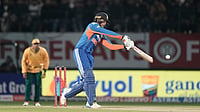In the UEFA Nations League, a continental tournament launched to replace meaningless international friendlies, League A is the creme and teams finishing first and second in each of the four groups progress to knock-outs, and fight for the title. (More Football News)
The group stage of the UEFA Nations League 2024-25 ended on Tuesday, but the action will continue with the quarter-finals (for League A) and many promotion and relegation battles.
By the way, the current edition is being played in an expanded format "with a new knockout round to be played in March 2025, thereby creating continuity". However, the format is still complex.
54 teams were divided into four leagues - 16 each for League A, League B, and League C and six teams of two groups in League D. Leagues A, B, and C have four groups of four teams each.
As formulated by the UEFA, the fourth-placed teams in Leagues A and B are relegated to Leagues B and C, respectively. The two lowest-ranked fourth-placed teams (with worst records) in League C are relegated to League D.
The four group winners in Leagues B and C and the two group winners in League D gained promotion to Leagues A, B and C respectively.
The third-ranked teams of League A, the runners-up of League B, the third-ranked teams of League B, and the runners-up of League C will play a home-and-away promotion/relegation play-off.
Here's how the promotion and relegation work:
In these play-offs, third-place teams in League A will play two-legged ties against second-placed sides from League B. The winners will stay or get promoted to League A.
The third-place teams in League B will take on the second-placed sides in League C, with winners joining League B in the next edition.
The two bottom-place teams in League C with the best record will play the runners-up of League D.
Here's the UEFA Nations League 2024-24 state of play after the end of the league stage:
Eight teams from League A qualified for the quarter-finals, for which the draw is scheduled in Nyon, Switzerland on November 22.
Teams in the last eight: Croatia, Denmark, France, Germany, Italy, Netherlands, Portugal and Spain.
Promoted teams
Promoted to League A: Czechia, England, Norway and Wales.
Promoted to League B: North Macedonia, Northern Ireland, Sweden and Romania or Kosovo.
Promoted to League C: Moldova and San Marino.
Relegated teams
Relegated to League B: Bosnia and Herzegovina, Israel, Poland and Switzerland.
Relegated to League C: Albania, Finland, Kazakhstan and Montenegro.
Relegated to League D: Azerbaijan, Lithuania
Teams to feature in promotion and relegation play-offs
League A & B play-offs: Austria, Belgium, Greece, Hungary, Scotland, Serbia, Turkey and Ukraine.
League B & C play-offs: Armenia, Bulgaria, Georgia, Iceland, Kosovo or Romania, Republic of Ireland, Slovakia and Slovenia.
League C & D play-offs: Gibraltar, Latvia, Luxembourg and Malta.
These play-offs will take place in March 2025.
It's pertinent to mention that since its inception in the 2018-19 season, three teams -- Portugal, France and Spain -- have lifted the trophy and pocketed handsome monetary rewards.
La Roja, who defeated Croatia in the 2023 UEFA Nations League final, collected 10.5 million euros while the runners-up received 9 million euros.
By the way, this edition of the Nations League is partially linked with European qualification for the 2026 FIFA World Cup. The four best-ranked group winners who do not finish in the top two of their respective World Cup qualifying groups will earn play-off spots through the Nations League.
As many as 16 European teams, an increase from 13, can qualify for the 2026 FIFA World Cup, to be held in Canada, Mexico and the United States. Of course, the 23rd edition of the football World Cup will have 48 teams, 16 more than the last seven editions of the tournament since 1998.
How does the 2026 FIFA World Cup qualification work for UEFA?
All teams representing all member associations (except Russia) will enter the qualifying round. These 54 teams will be divided into twelve groups of four or five teams each.
The winners of each group will directly qualify for the World Cup finals (from the first round itself); the second-placed teams, along with the four best-ranked group winners from the Nations League that finished outside the top two, will play in the play-offs (second round).
The draw for the first round of the European qualifiers for the FIFA World Cup 2026 will be held on December 13, 2024, at the FIFA headquarters in Zurich, Switzerland.
The qualifiers will run from March 2025 to March 2026 with the play-off finals deciding the final European for the World Cup in the Americas.




























